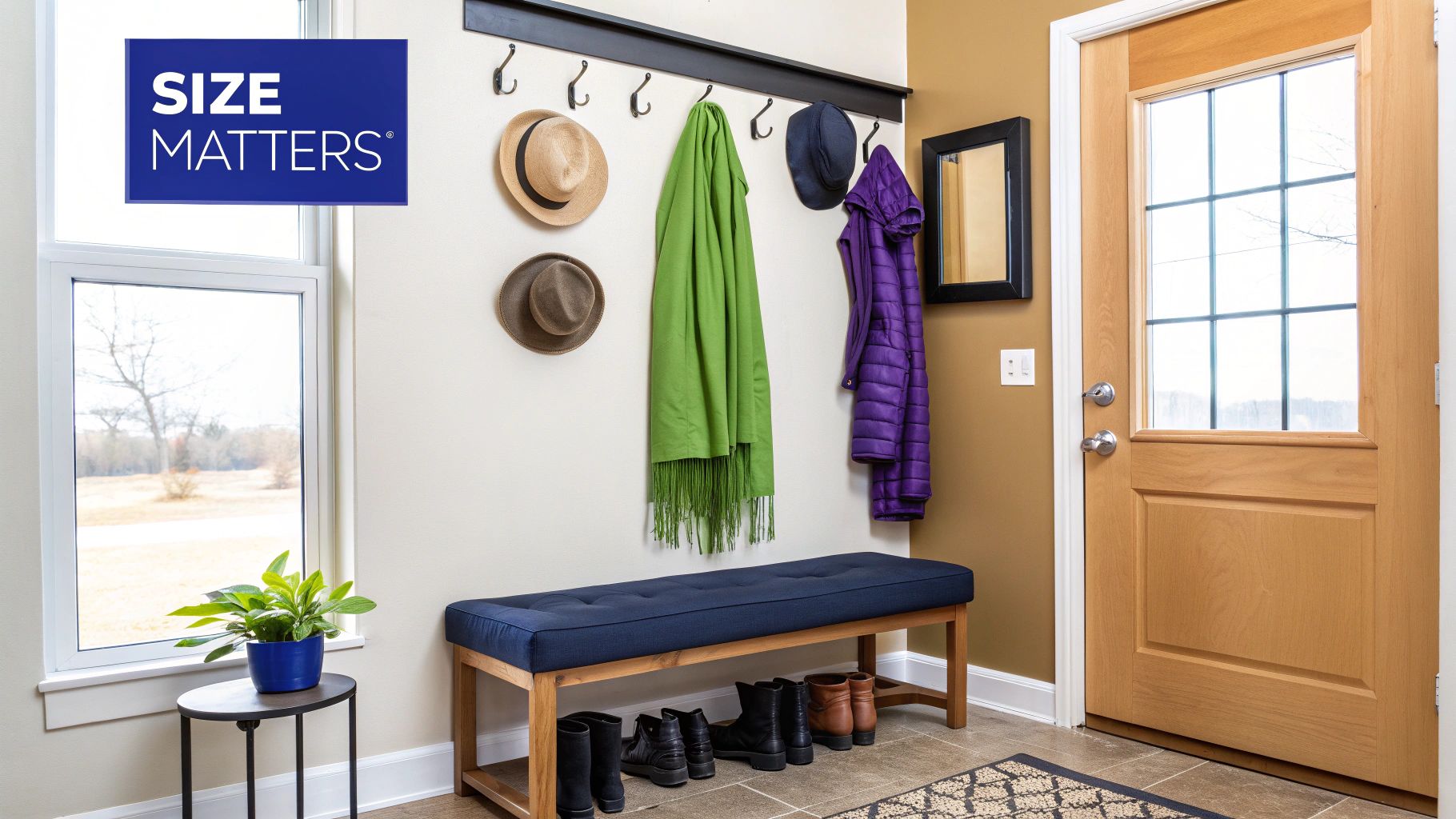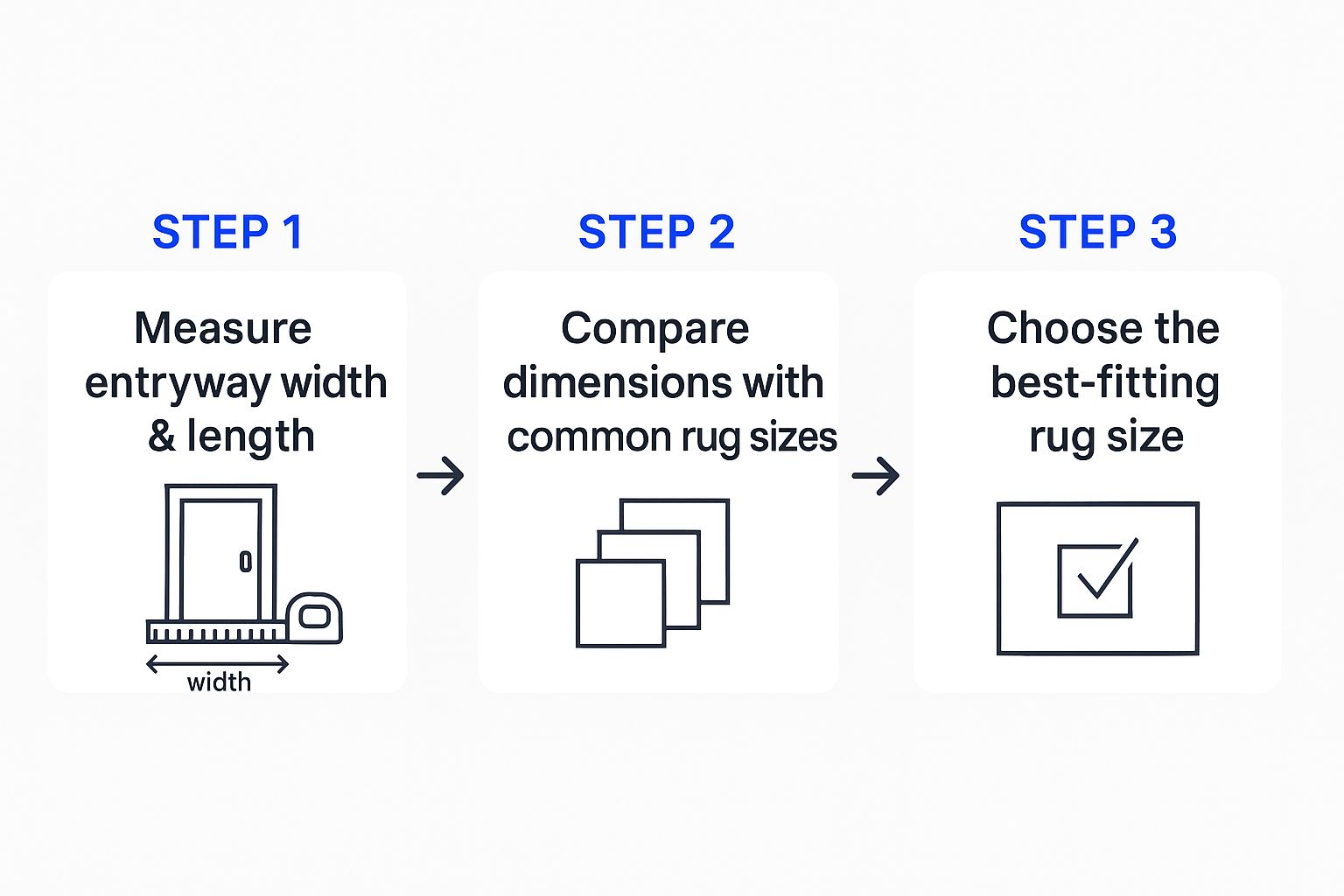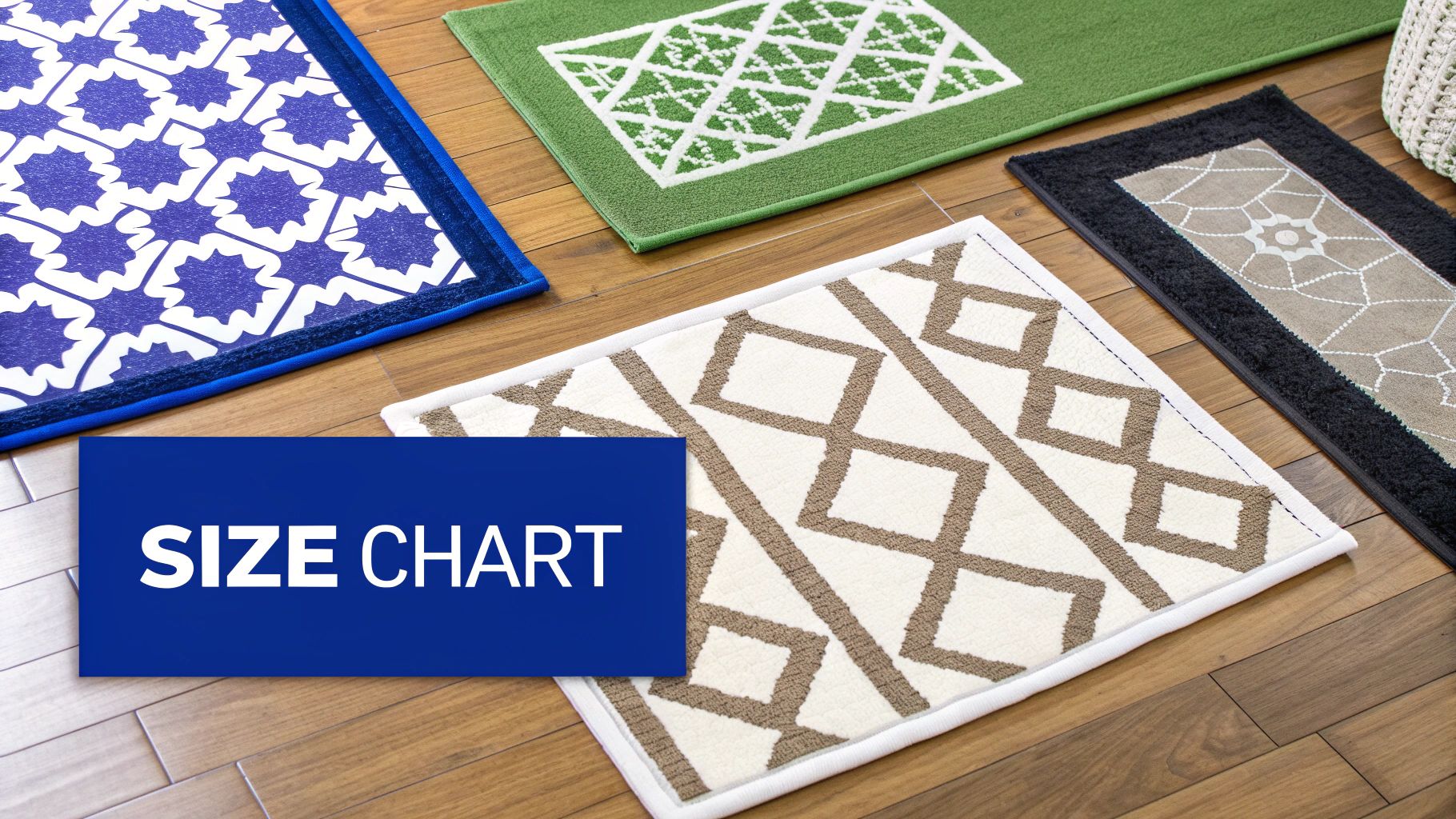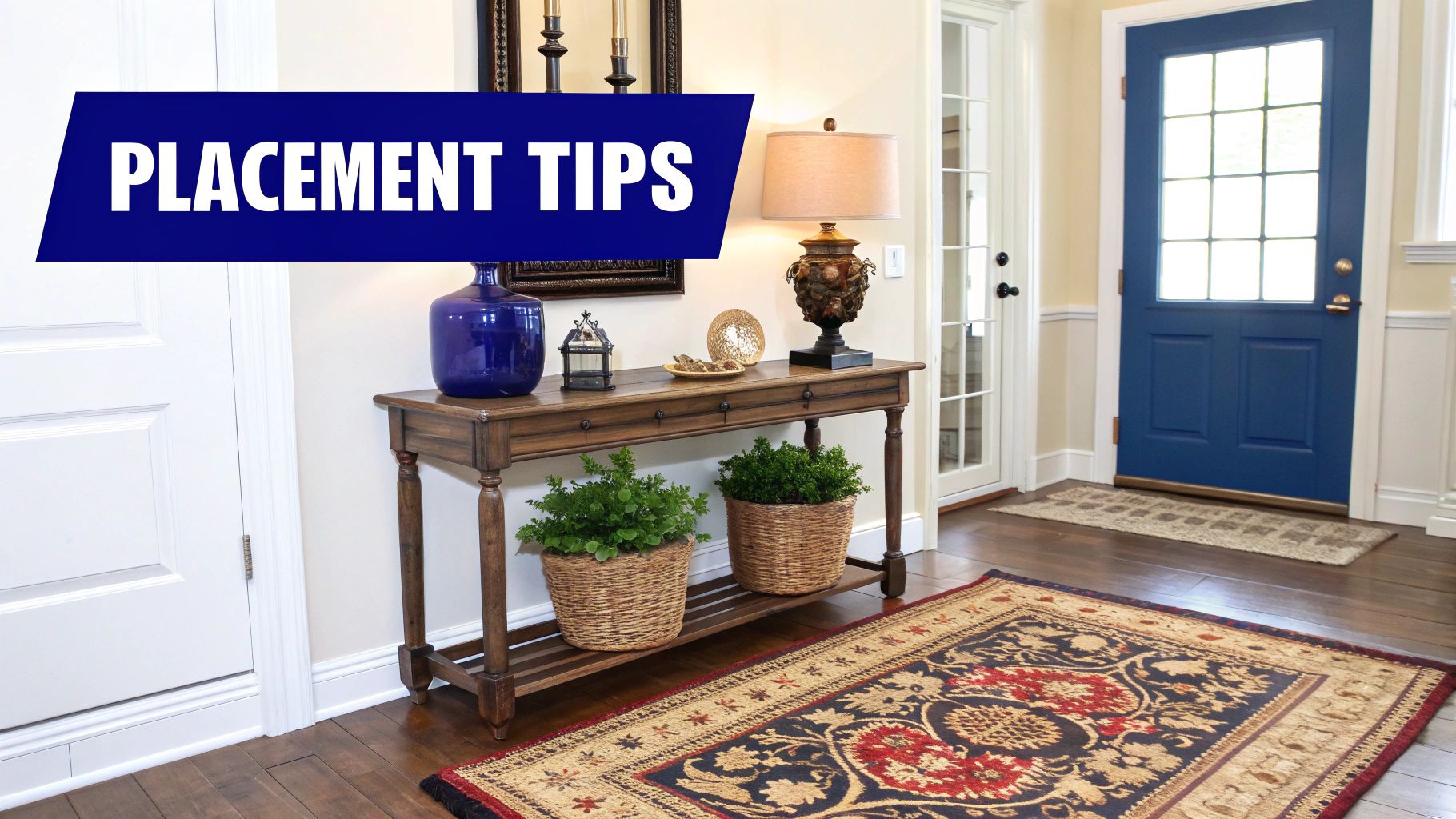Getting the right entryway rug size is the secret to nailing a great first impression. The most crucial rule is that your rug should be at least as wide as your door, but ideally a little wider. To be precise, aim to cover about 80% of your entryway's width. This ensures it effectively stops dirt and moisture in its tracks without visually overwhelming the space.
Why the Right Rug Size Creates the Perfect Welcome

An entryway rug is more than a place to wipe your feet—it's your business's or home's first handshake. It sets the tone for the entire space, and getting the size right is crucial. If the dimensions are wrong, the area can feel off-balance or incomplete, undermining both its appearance and its function.
A rug that's too small looks like a postage stamp in a grand hall; it feels like an afterthought and won't effectively protect your floors. Conversely, a rug that's too large can make an entrance feel cluttered, become a tripping hazard, or even prevent the door from opening properly—a major safety and convenience issue.
The Benefits of a Perfectly Scaled Rug
Nailing the size of your entryway rug delivers practical benefits that go beyond aesthetics. It's a hardworking asset that helps maintain your property and keep it safe.
When you get the dimensions right, your rug can:
- Protect Your Floors: It provides enough surface area to trap dirt, moisture, and debris from shoes before it gets tracked onto your expensive hardwood, tile, or commercial-grade flooring. This directly reduces cleaning costs and preserves the life of your floors.
- Enhance Safety: A properly scaled rug offers a stable, non-slip surface where it's needed most. This is critical for preventing slips and falls, especially when floors are wet from rain or snow, reducing liability risks in a commercial setting.
- Create Visual Harmony: The right rug grounds the space. It guides the eye from the front door into the rest of the building, making the entryway feel deliberate, polished, and thoughtfully designed, which enhances your brand's image or home's appeal.
Actionable Takeaway: The goal is to create a "landing zone" that feels both generous and proportional. This zone should be large enough for a person to comfortably stand, close the door, and remove their shoes or shake off an umbrella without stepping off the mat.
This focus on functional detail is part of a larger trend. In 2024, the global carpets and rugs market was valued at nearly USD 58.93 billion and is projected to grow significantly. This shows how much businesses and homeowners are investing in details like entryway rugs to improve their spaces.
A well-chosen rug is an investment in cleanliness, safety, and brand perception. For more ideas on optimizing this critical area, explore our complete guide to entrance floor mats.
Your Four-Step Method for Measuring Any Entryway
Forget guesswork. Choosing the perfect entryway rug starts with a tape measure. By following this straightforward, four-step process, you can measure your space with confidence and find a rug that fits perfectly and performs its job flawlessly.
Your first move is to get a baseline measurement of your front door. This one number is the most critical piece of the puzzle.
Step 1: Measure Your Door Width
Your front door is the focal point of your entryway, so any rug must be proportional to it. Use a tape measure to find the width of the door itself—not the doorframe.
How-To Rule: Your rug should be at least 80% of your door's width.
Business Example: For a standard commercial 36-inch door, you need a rug that’s at least 29 inches wide (36 x 0.80 = 28.8). This simple calculation ensures the rug looks substantial and provides enough surface area to catch dirt as people walk in. A narrow runner in front of a wide door looks unprofessional and is ineffective.
Step 2: Check Your Door Swing Clearance
Next, assess how your door operates. Swing it fully open and measure the distance from the doorframe to the far edge of the open door. Just as importantly, check the gap between the bottom of the door and the floor. This measurement is your maximum pile height—the thickest your rug can be.
A high-pile, plush rug might seem luxurious, but if it catches on the door, it becomes a major annoyance and a tripping hazard. Most modern doors have enough clearance for a standard low-to-medium pile rug, but measuring first is always the smart move.
This little infographic breaks down the whole process visually, from measuring up to picking the right size.

It helps to see the flow from taking measurements to comparing them with standard sizes, making the final choice feel much less daunting.
Step 3: Assess the Total Available Floor Space
Now, zoom out and look at the entire entryway. Measure the total width and length of the open floor space where the rug will go. The goal is to find a rug that covers the main traffic path without overwhelming the area.
Actionable Tip: You almost always want to leave a border of visible flooring around your rug. Aim for at least 3-6 inches of bare floor on all sides. This creates a cleaner, more defined look and prevents the entryway from feeling cramped.
Step 4: Account for Furniture and Layout
Finally, take stock of any furniture in the space—a console table, a reception desk, a bench, or a coat rack. You need to decide how the rug will interact with these pieces. Do you want the furniture entirely on the rug, partially on it (front legs only is a popular choice), or completely off it?
- Commercial Example: In a hotel lobby, a large custom mat might extend under a console table and several chairs, creating one cohesive and impressive welcome zone. This anchors the furniture and protects a large area of flooring.
- Residential Example: In a typical home foyer, placing just the front two legs of a bench on the rug is a great trick. It connects the furniture to the rug, making the whole area feel more integrated and intentional.
If you have double doors or sidelights, treat the entire unit as one wide entrance and apply the same 80% rule to the total width. Follow these four steps, and you’ll have the exact dimensions needed for a rug that fits your unique entryway perfectly.
Understanding Standard Rug and Doormat Sizes

Alright, you have the exact dimensions of your entryway. Fantastic! Now comes the fun part: turning those numbers into a real-world rug that looks and feels just right.
When you start shopping, you’ll find that rugs and doormats come in standard sizes. These aren't random; they are designed to fit the most common door and entryway layouts. Let's break down these sizes and their ideal applications.
Small Doormats (18" x 30")
The classic 18" x 30" doormat is the most compact, go-to size. It’s specifically designed for single doors where space is limited.
- Best For: Standard single doors (usually 30-32 inches wide) in tight spots like apartment doors or secondary entrances.
- Real-World Example: An 18" x 30" mat is perfect for the back door of a restaurant leading to the kitchen. It provides a dedicated spot for staff to wipe their feet without obstructing a narrow, high-traffic walkway. It's also an ideal size for an outdoor mat placed right at the threshold.
Standard Entryway Rugs (24" x 36")
The 24" x 36" rug is the most popular and versatile choice for the average home or small office. It’s wide enough to feel substantial in front of a standard 36-inch door, offering much better coverage and creating a more generous landing pad.
This size hits the sweet spot between function and style, giving visitors plenty of room to step inside and clean their shoes. It’s the reliable workhorse that perfectly fits the 80% rule for most single doors.
Actionable Takeaway: If you're ever unsure, the 24" x 36" is often the safest and most effective choice for a standard single entryway.
Large Entryway Rugs (36" x 48")
For a grander entrance—like double doors or a wide single door with sidelights—a 36" x 48" rug is a great fit. This larger size creates a more impressive welcome and does a brilliant job of anchoring the entire space.
It ensures that no matter which door someone uses, there’s plenty of matting underfoot to catch dirt and moisture. This is all about creating a feeling of spaciousness and preparedness from the very first step.
Entryway Runners
Runners are the heroes of long, narrow hallways and entryways. They are fantastic for drawing the eye forward, visually elongating a space, and guiding visitors from the front door into the main part of the building. Common runner sizes include:
- 2.5' x 7'
- 2.5' x 10'
- 2.5' x 12'
Commercial Example: A medical clinic often uses a long runner in the corridor leading from the entrance to the reception desk. This not only protects the flooring in a high-traffic area but also creates a clean, professional visual path for patients, enhancing their experience and improving safety.
These standard sizes are a key part of the global area rugs market, which was valued at a massive USD 36.5 billion in 2024. This growth shows how essential these functional pieces of decor are for businesses and homes alike.
Matching the Rug to Your Entryway's Layout
You have your measurements and a grasp of standard sizes. Now, let's connect those to the shape and flow of your entryway. Every entrance is unique, and the right rug must work with its architecture, not against it.
Let's walk through the three most common entryway layouts and how to choose the right rug for each.
The Small Apartment or Compact Entry
In a tight space, the goal is to create a defined landing zone without making the area feel smaller. Precision is key.
- Best Rug Size: An 18" x 30" or a slightly larger 24" x 36" rug. These sizes provide enough surface to wipe feet without consuming the entire floor.
- Actionable Tip: Place the rug directly in front of the door, ensuring it's slightly wider than the door itself. Leave a clear border of flooring on the other three sides. This creates a clean, orderly feel, which is essential in a small space.
- Benefit: This approach maximizes function in a minimal footprint, keeping your small entrance clean and uncluttered.
The Traditional Square Foyer
A classic square or wide foyer gives you more room to make a statement. A tiny doormat will look lost and unprofessional. You need a rug with presence to properly anchor the space.
A generous rug does more than protect the floor; it defines the foyer as its own distinct "room," creating a more luxurious and welcoming first impression.
Real-World Example: The reception area of a corporate office doesn't use a tiny mat. It uses a large, impressive one to set a professional tone and manage foot traffic. The same principle applies at home: a substantial rug in a square foyer signals a warm, well-designed welcome.
- Best Rug Size: Go bigger. A 36" x 48" or even a 4' x 6' rectangular rug will feel appropriate. A 4’ or 5’ round or square rug can also be a fantastic choice, breaking up the straight lines of the walls and doorframe.
- Actionable Tip: Center the rug in the foyer for maximum impact. If you have a console table, either place the rug in front of it or tuck just the front legs of the table onto the rug for a more integrated look.
- Benefit: A large rug makes the entryway feel more grand and intentional, enhancing the user's first impression of the space.
The Long and Narrow Hallway
Long, skinny hallways present a unique challenge. A standard rectangular mat can look awkward, visually disrupting the flow. The solution is a runner.
Runners are designed to complement this layout, creating a clear visual runway that guides guests from the front door into the main space. For a deeper dive, see our guide on choosing the right floor mat for your needs.
- Best Rug Size: A runner, typically 2.5' wide and anywhere from 7' to 12' long.
- Actionable Tip: The key to placing a runner is to leave an equal border of flooring on both long sides. Aim for at least 3-5 inches of exposed floor on each side.
- Benefit: This prevents a "wall-to-wall carpet" look and actually makes the hallway feel wider and more spacious while protecting the high-traffic path.
The Most Common Sizing Mistakes and How to Fix Them

Even with good intentions, it's easy to get entryway rug sizing wrong. The good news is that learning from common mistakes is the fastest way to get it right.
Let's review the most frequent sizing errors and their simple, practical solutions.
Mistake 1: The Tiny "Postage Stamp" Rug
This is the number one mistake. A tiny rug in front of a standard or large door looks unbalanced and unprofessional. Functionally, it fails because visitors can barely get one foot on it. Aesthetically, it throws the room's proportions off.
- The Problem: The mat is much narrower than the door, making the space feel poorly planned.
- How to Fix It: Follow the 80% rule. Your rug should be at least 80% of your door's width. For a standard 36-inch door, choose a rug that’s at least 29 inches wide. This single guideline instantly makes the rug look intentional and more effective.
Mistake 2: The Door-Blocking Rug
There's nothing more frustrating than a rug that catches on the door. This is a classic functional failure, usually happening when the rug's pile is too thick for the door's clearance. It’s an immediate signal of a poor fit and a daily annoyance.
- The Problem: The rug’s thickness obstructs the door’s path, causing it to jam or curl.
- How to Fix It: Before you buy, measure the gap between the bottom of your door and the floor. That measurement is your maximum pile height. Stick to low-profile rugs in high-traffic entryways to guarantee a smooth door swing. A clean mat is also less likely to snag; learn 5 tips on how to keep your entrance mat clean in our other guide.
Mistake 3: The "Floating" Rug
A "floating" rug is one placed awkwardly in a larger entryway, too far from the door and disconnected from furniture like a bench or reception desk. Instead of defining a clear landing zone, it makes the space feel disjointed.
- The Problem: The rug isn't grounded by the door or nearby furniture, so it looks lost.
- How to Fix It: Anchor your rug. Place it directly in front of the door. If you have an entryway table or bench, tuck the rug just under its front legs. This simple trick visually connects the rug to other elements, creating a cohesive and deliberate look.
Digging Into Your Top Entryway Rug Questions
Even with a guide, specific questions often arise. We've gathered the most common queries to give you the final boost of confidence you need to choose the perfect rug.
Should My Entryway Rug Be Wider Than the Door?
Yes, absolutely. This is the most important takeaway. A rug that’s the same width as the door—or narrower—looks skimpy and fails to create a generous, welcoming “landing pad.”
A wider rug feels more intentional and balanced, giving people enough room to step inside and close the door without teetering on the edge of the mat.
- The Rule of Thumb: Your rug should extend a few inches beyond the doorframe on both sides. Aiming for the rug to be about 80% of the total entryway width (not just the door) is a great target.
- Real-World Example: In a retail store with a 36-inch door, a small 24-inch wide mat looks cheap. Swapping it for a 36-inch or 48-inch wide rug instantly makes the entrance feel more professional and welcoming, improving the customer experience from the first step.
What Rug Shape Is Best for a Small Entryway?
For a tight or compact entryway, a classic rectangular rug is almost always your best bet. Fun shapes like circles can create awkward gaps and don't protect the floor effectively at the threshold.
A rectangle maximizes floor coverage where it counts, creating a clean, defined space without adding clutter.
- The Logic: Rectangles align perfectly with the existing lines of the doorframe and walls, making the area feel more orderly.
- Real-World Example: In a small office entryway that's only 4 feet wide, a 2' x 3' (24" x 36") rectangular rug is a perfect fit. It provides all the necessary function without making the space feel cramped, leaving a neat border of flooring around it.
A well-placed rectangular rug acts as a visual anchor in a tight space, establishing a clear purpose and making the entryway feel more organized.
How Much Space Should I Leave Between the Rug and the Wall?
Always leave some "breathing room." Pushing a rug right up against the walls can make it look like ill-fitting carpet, which visually shrinks the entryway. A border of exposed flooring frames the rug and helps define the entry as a distinct zone.
- The General Guideline: Leave about 3 to 6 inches of visible flooring between the rug's edges and the walls.
- For Runners: This rule is especially critical. A runner needs at least 3 to 5 inches of bare floor on each long side to prevent the hallway from feeling constricted.
Can I Layer Entryway Rugs for More Style?
Absolutely! Layering is a fantastic way to combine the durability of a base mat with the style of a decorative top rug. This technique is perfect if you find a beautiful rug that's too small on its own or if you want to add a seasonal touch.
- How It's Done: Start with a larger, low-profile base rug made of a durable material like jute or a tough outdoor-rated synthetic. On top, place your smaller, more decorative rug.
- Real-World Example: A business could use a large, neutral 4' x 6' scraper mat to handle heavy foot traffic and moisture. For a promotion, they could layer a smaller 2' x 3' custom logo mat on top to greet customers with an on-brand message. This delivers rugged function and stylish, timely marketing.
Armed with these answers, you're ready to choose the perfect mat with total confidence. Here at Mats4U, we specialize in high-quality, durable matting solutions for every kind of entrance, from a home foyer to a busy commercial doorway.
Take a look through our collection and find the ideal mat to make your home or business shine.
Discover the perfect entrance mat at Mats4U
Article created using Outrank







